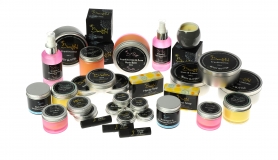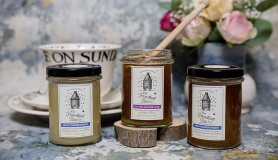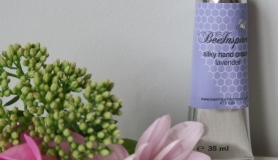Ever since we bought our house in the heart of South London, we’ve been on a mission to make it as green as possible. One of our dreams was to grow our own fruit and veg with the help of our children, but we have had to pretty much admit defeat as the shade from the beautiful old apple trees slows everything down and even when plants grow, armies of slugs and snails devour them.
But we have always talked about keeping bees and eventually took the plunge, by enrolling onto a beekeeping course, held in a parish hall in Hampshire. This weekend workshop wasn’t just an introduction into beekeeping but also into the ways of beekeepers, truly a unique bunch. So many terms, anecdotes and rules literally flew over our heads as we sat in equal parts bemused and enthralled. Yet, inspecting a beehive for the first time, and hearing how one woman had successfully kept bees on Covent Garden rooftop, inspired us with confidence that we too could become urban beekeepers.
Several trips to bee equipment suppliers later, we had built and installed our first hive in the corner of the garden where the morning sun would hit it (honey bees are sleepyheads and need a good dose of warmth to get flying). I would like to say that the DIY and building skills involved had enticed the children into our new venture but mainly they looked on with a sceptical teenage eye as we hammered, nailed, and gradually prepared ourselves. We also visited our new mentor regularly – a lifelong beekeeper with a hive in his back garden in Brixton – who generously shared coffee, anecdotes and the art of beekeeping with us.
Learning the ropes
And what an art it is! There is definitely more to it than meets the eye and I often felt quite daunted after our visits. Keeping bees in a densely populated city, we have to be really careful to guard against swarms (not popular with the locals) and disease, one of the main problems for honeybees. We attended another beekeeper workshop, held in a secret garden behind Oval tube station, where we saw at first-hand the ravages of diseases such as foul brood, deformed wing and varroa mites. It all sounded so scary! I have to admit at this point I was ready to put my lovely pink bee suit in the loft and return to planting cabbages for the slugs to feast on.
But my husband was undeterred. He joined a WhatsApp group that notified beekeepers of swarms in the area – collect them and they’re yours. As this was May, it wasn’t long before a suitable swarm had been spotted. Off drove my husband in his plumber’s van, bee suit, smoker and bee box at the ready. I think the return journey across Tower Bridge with a box of bees buzzing on the front seat was one of the most nerve-wracking trips he’s ever made. However, swarms are actually very placid as the bees have filled their tummies with honey and have nothing to defend, so are unlikely to sting anyone. Still, you wouldn’t like to take the risk!
New parents!
We were like new parents for those first few weeks and we even made the same basic error we made with our firstborn – didn’t feed enough! We hadn’t realised that there is a June gap; while bees need lots of water and nectar to build new honeycomb, if this coincides with a gap between spring and summer blossom, then you have to feed them. The children were brilliant at stirring the syrup made of granulated sugar diluted with water and placing it on the special feeder tray in the hive, watching fascinated as the bees crawled up to gorge on syrup.
Getting the queen settled
Anxiously, we inspected weekly and soon noticed that there didn’t seem to be any new baby bees. We had learnt early on to monitor levels of “brood”, that is eggs, tiny specks practically invisible to the naked and untrained eye, larvae and capped cells, under which the larvae are pupating into bees. Our ever patient mentor explained that our queen bee was either not laying or had never actually returned from her mating flight. Now what to do? Order another one, of course! She duly arrived in a jiffy bag, entourage of worker bees and stores of fondant at the ready. We gently inserted her into the hive with a sheet of newspaper between her little cage and the rest of the hive, so that by the time she had gnawed through the paper, our existing bees had got used to her smell and welcomed her into her new home.
Could we finally relax? New eggs, brood and emerging bees were rapidly appearing. The children were brilliant at spotting baby bees and laughing as they gradually ate their way out of their nursery cells. But then disaster struck again!
One Sunday as we were inspecting a bit more confidently than before, we came across cells filled with a grey sticky substance. Remember the disease workshop we attended? It came lurching back to my mind. Oh no! Was this European Foul Brood – recognisable by a grey sticky coating on brood cells and deformed larvae below? Visions of having to destroy the bees, dig a hole and burn the hive under the strict eye of the bee inspector came to mind. My calmer husband sent a photo to our long-suffering mentor, whose one-word text hid depths of despair at our panic – “pollen”! Yes, pollen comes in a huge spectrum of colours from white, yellow, green, brown to almost black. Who knew? We did now.
Fast Forward 12 Months
Winter passed quickly with our only duties being to keep the bees topped up with fondant (they had produced very little honey that first summer, which we had simply left in the hive) and keeping the roof on to keep them warm and increase their chances of survival. On a sunny afternoon in early March, I first noticed activity around the hive. They were alive and flying out to forage. The term busy bee has never seemed more apt. It was entrancing and relaxing to sit on the bench watching them. In really warm sunshine, the end of the garden resembled Heathrow’s flight path (before it fell silent due to this year’s events). And so began our spring of beekeeping, checking weekly to ensure the hive was “queen right” and free of disease.
You might remember that I mentioned how letting your bees swarm is an absolute no-no in the urban beekeeper’s world. It is a natural instinct that drives bees to split a colony by breeding a new queen. They then fly off with her to find a new home, leaving a depleted colony behind in your hive. Not only does it mean you have fewer bees but that your neighbour might be the unhappy recipient of new ones. But how do you stop them? The only way is to keep an eagle eye out for the notorious queen cell – a peanut-shaped object often hanging at the bottom of a frame. This will hold the beginnings of a new queen bee complete with royal jelly and a spacious chamber. If you spot one of these, you have to divide your hive so that the bees think they’ve swarmed and settle back down to collecting nectar and bringing up normal worker honey bees.
This is as tricky as it sounds. We didn’t want to upset our bees or destroy either the old or emerging queen. We all got to work duly building a new hive (you have to react quickly to bees) and a day or two later we set about carefully transferring the frame with the queen cell, plus entourage, to their new home.
Cue more watching and waiting with fingers crossed. We left the bees in peace and two weeks later were rewarded with the sight of a brand new queen bee calmly wandering over the comb, laying eggs and buzzing to her loyal fans.
Another sigh of relief and as the summer progressed, our son became a regular member of the team, adding to his Duke of Edinburgh skills. Both children have learnt not to be scared of bees anymore; that they rarely sting and if they do, it’ll be OK. My son has been very interested in the hive and making its components, so has developed woodworking skills, while his sharp eyes have helped us spot our elusive queens during inspections.
Honey Harvest
As the bees continued to forage successfully within their three-mile radius of our house, visiting neighbouring gardens and the huge variety of trees on our local common, we added extra boxes with the frames that bees fill with comb and honey, so that by the end of July, we had five layers on each hive, full of fragrant honey, safely sealed in its wax chamber. It was time to take some of these boxes off before the hive toppled over.
So, time to tackle the equipment and lore of honey harvesting. This became a full family affair. Dad brought the frames in, making sure all the doors and windows were shut to avoid being chased by cross bees; the children carefully uncapped the honey with a breadknife and we all watched spellbound as the extractor spun the honey out of its combs. Once it was all at the bottom of the drum, we opened a tap and out poured this delicious, amber syrup fragrant with the scent of blossom. Then followed the sticky process of filtering the honey through sieves of different sizes to remove all traces of comb and insect, ripening (letting it sit for 48 hours so that the air bubbles disperse) and then finally the super proud moment of pouring honey into sparkling glass jars ready to be spread on toast, used as a cold remedy, or in my case, simply eaten directly by the spoon! There is no real way to thank our bees but we have of course left them with a box full of honey on each hive to see them through the winter.
Honey and beeswax production has inspired our children in many creative ways. One made a beautiful hand-painted design for our labels which proudly adorn all the jars. They both helped pour and weigh out the honey and have been enthusiastic vendors, carefully counting the proceeds and planning what to do with it. We have also ventured into processing the beeswax which has entailed researching cosmetic recipes and candle-making, as well as some very sticky pans.
Beekeeping really has been a family adventure, even if the children were sometimes sceptical observers. They have learnt a lot about animal husbandry and it has made us all more aware of the changing seasons, the way our local plants can sustain bees, as well as different species of bees, hoverflies and wasps. In our built-up urban environment, I am really pleased that the beehive has given them a glimpse of a more traditional, rural pursuit in tune with the seasons and nature’s lifecycle.
Alison lives in southwest London with husband, two children, two cats and two beehives. They all try to live as greenly as possible in an urban setting. When not extracting honey or rendering beeswax, Alison enjoys writing, gardening and cooking.
Twitter: @AlisonWareham1







